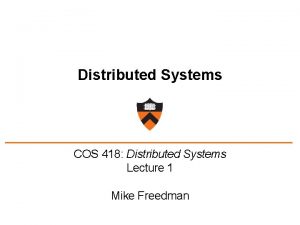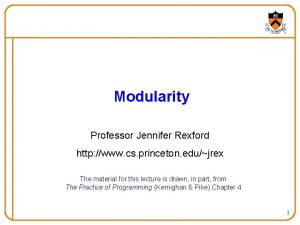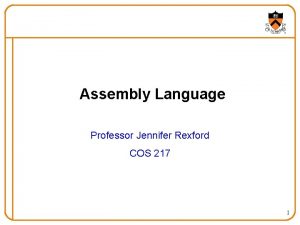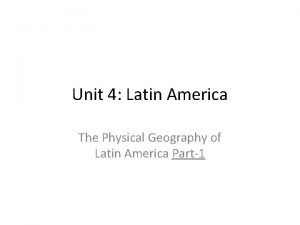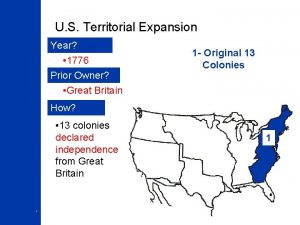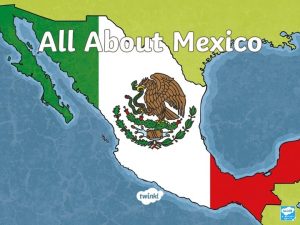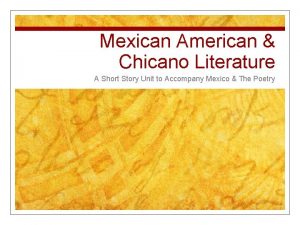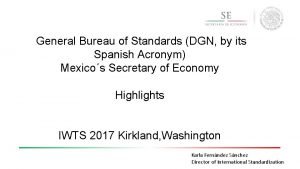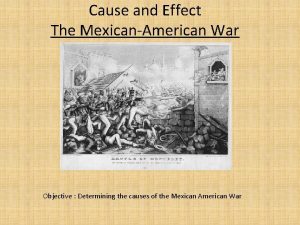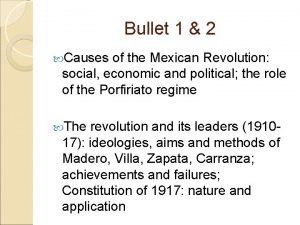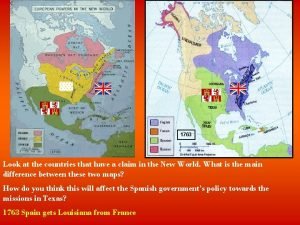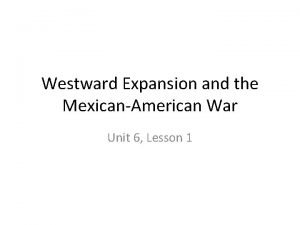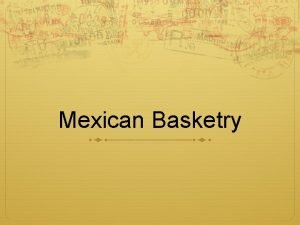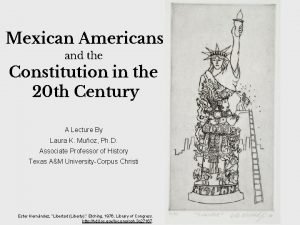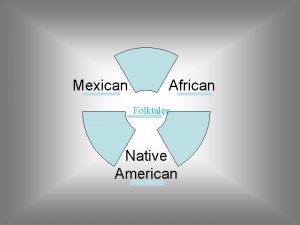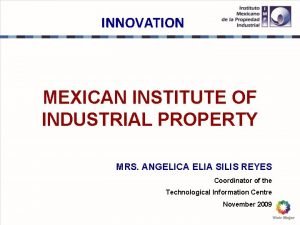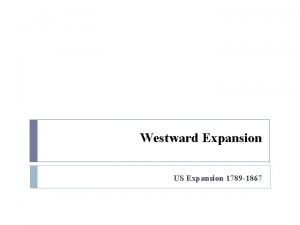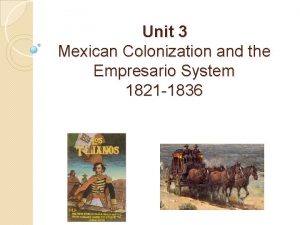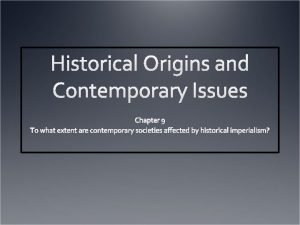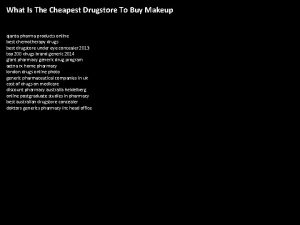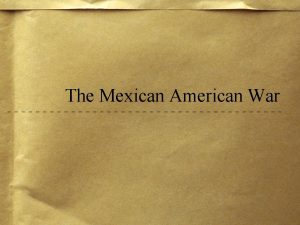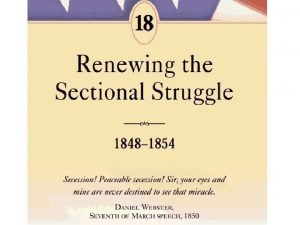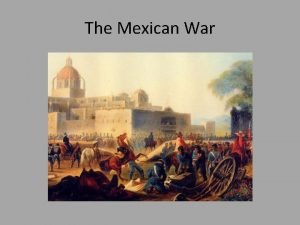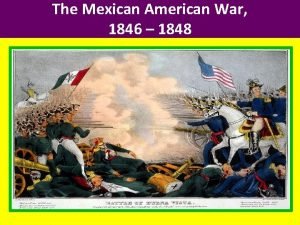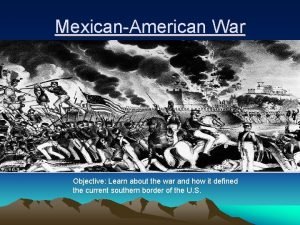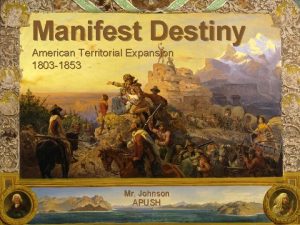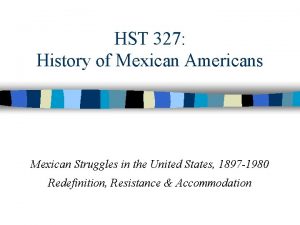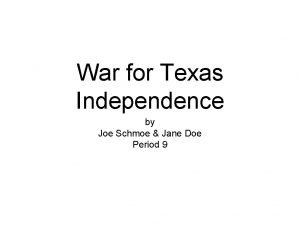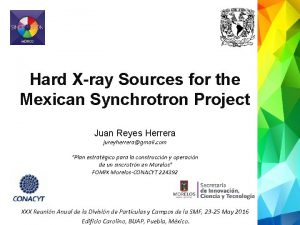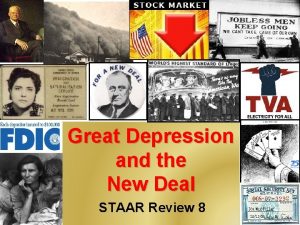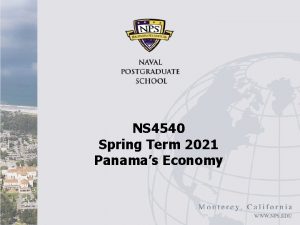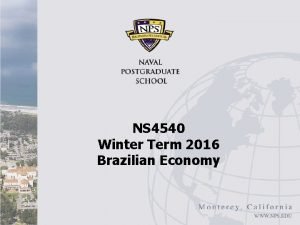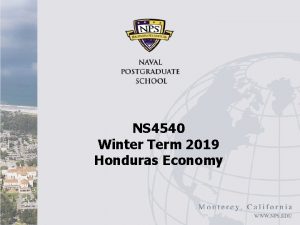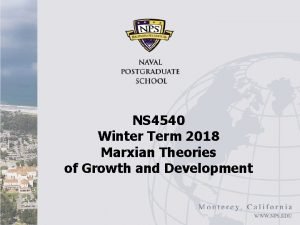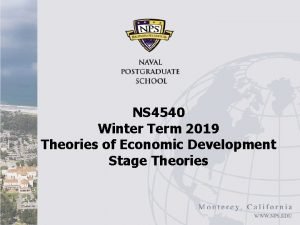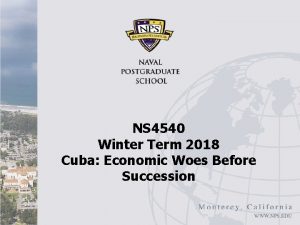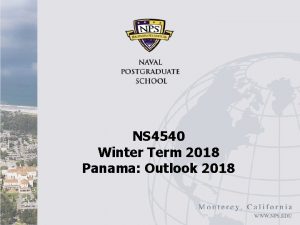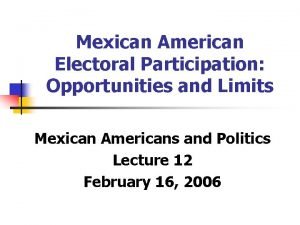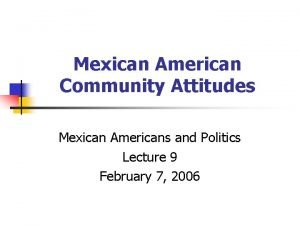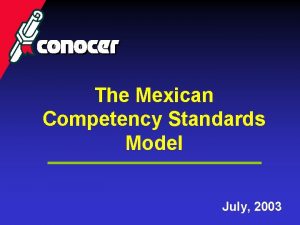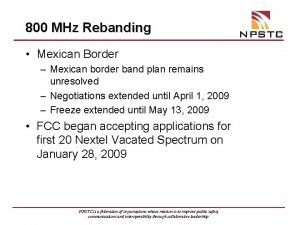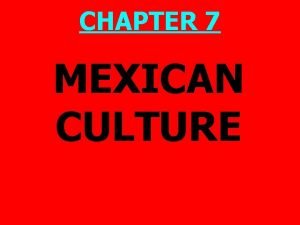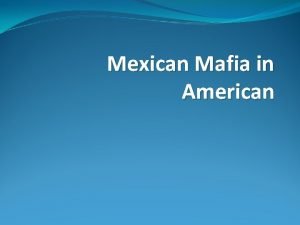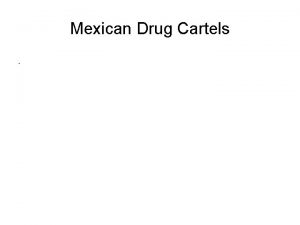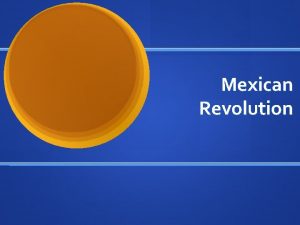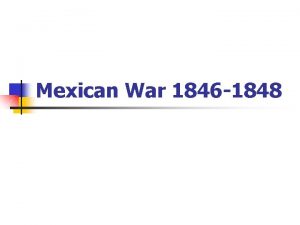NS 4540 Spring Term 2021 The Mexican Economy
























































- Slides: 56

NS 4540 Spring Term 2021 The Mexican Economy

Overview I • Mexico’s economy has fluctuated between 11 th and 15 th largest in the world since the 1980 s • The ppp per-capita income is around US $20, 411 • World Bank classifies the country as an upper-middle income country • Mexico only one of 15 countries with a GDP larger than $1, 000 m • Population 129 m with 40% under age 30 • Country has a significant potential to grow at high rates (5% or more per year) over the next two or three decades • Mexico has the largest number of free trade agreements in the world – 44 including USMCA • Country also a member of the G 20 and the OECD 2

Overview II • Despite such a promising profile, Mexico’s growth and development has disappointed since the 1980 s. • Average growth since second half 90 s around 2% rather than 5% needed to make transition to upper income country • Structural conditions proved difficult to change • Economic policies led to • Inefficiency, • High indebtedness, • Corruption, and • Recurrent financial crisis • This took place in an increasingly competitive international marketplace • These all contributed to keep Mexico on a low-growth trajectory during the last three decades 3

Overview III • Political and economic consequences of long-term sluggish growth in context of a fiscally weak state incapable of progressive redistribution included • An intensified politicization of growing socioeconomic inequality • Mexico ranked as one of the top 20 most unequal countries in the 2000 s • COVID-19 pandemic escalated in early 2020 and expected to cause the economy to shrink by at least 7% • Absence of economic stimulation through expansionary monetary and fiscal policy and continuing austerity does not bode well for the short-and medium term economic growth and socio economic development of country 4

Overview IV • Phenomenon of great inequality and poverty historically rooted in • Race • Ethnicity, • Region, • Urban-Rural differences and • Critically -- connections (or their absence) with politically and/or dominant individuals and groups • Economy remains dualistic with modern and traditional sectors co-existing 5

Overview V • Mc. Kinsey report (2014) – identified two Mexicos • First one is • Modern • Integrated with US and Canada • Led by manufacturing and high-productivity growth • Second • Traditional, backward and • Reliant on informal employment for services and subsistence agriculture • More than 2/3 of working population in the low-growth traditional economy 6

Overview VI • In sum, Mexican economy characterized by deep contradictions • Open to world competition • But its main domestic sectors remain heavily concentrated in monopolies or oligopolies • This may change due to the structural reforms undertaken in 2013 and 2014 • Mexico is home to a sizeable number of highly educated competent professionals • But its governments and businesses are run through cronyism rather than merit 7

Overview VII • Governments display the trappings of powerful authority • But pubic finances are very weak and greatly dependent on oil revenues • All of the institutions, rules and human resources are in place to enforce the rule of law • But justice is politicized, property rights are vulnerable and the criminal justice system is corrupt • The formal economy includes global leaders in their fields such as PEMEX (oil), Cemex (cement), and Grupo Bimbo (baking) • But an estimated 30% - 50% of total economic activity takes place in informal sector (including highly profitable illegal narcotics trade) 8

Overview VIII • Concern is that the weak rule of law and cronyism that have characterized political and economic life will enable the powerful companies dominating the main sectors of the economy to • Not only remain in a very strong position in their traditional areas of activity but also • Expand to the newly opened sectors • New concerns involve President Lopez Obrador and his • Mismanagement of the pandemic • Preference for capital intensive mega projects 9

Overview VIII 10

Mexico Patterns of Governance 11

Early Economic History: I • Modern Mexico starts with the dictatorship of Porfirio Diaz (1876 -1911) • At the start of this period Mexico’s per capita income about 1/10 that of the US • Still period saw fast sustained growth • Gap with US stopped growing and industrialization began • Key enabler of growth was the creation of a rail network – joined markets and helped create a national economy • Peace and growth under Diaz attracted large amounts of foreign investment • With Brazil and Argentina, Mexico became an early industrializer with the development of smelters, steel, textiles and manufacturing. 12

Early Economic History: II • Economic growth very unevenly distributed and growing industrial production and capitalist agriculture came at the price of very significant income and wealth concentration. • Election fraud in 1910 and growing discontent prompted rebellion organized by a variety of: • Worker groups, • Peasants • Middle Class and even • Elite forces • In end a revolution lasting from 1910 to 1920 • Disrupted population and economic growth 13

Early Economic History: III • New Constitution built on principles of state intervention for the promotion of social justice via: • Public education • Communal landowning and • Robust labor rights • After a turn towards capitalism in the 1920 s country titled towards socialism under President Lazaro Cardenas (1934 -40) • Large scale land redistribution via communally held ejidos and • Nationalized the oil industry, creating PEMEX 14

Early Economic History: IV • Political economy functioned under PRI, the dominant political party that • Supported popular progressive causes • Was nationalistic and • Relied on the state as the main propelling and steering force of the country’s destiny • However economy mainly relied on domestic and international private investors • PRI controlled • organized workers, • peasants and the • middle classes connected with the public sector 15

Early Economic History: V • The PRI also crafted an informal agreement with domestic and foreign investors to: • promote capital accumulation and growth and • Contain popular demands and dissidence by intellectuals and radical political activists (in exchange for the gradual satisfaction of social demands) • Years from 1940 to 1970 known as the “Mexican Miracle” • Period of import substitution industrialization (ISI) • Average annual rates of growth of 6 -7% and • Inflation below 5% • significant modernization, urbanization, industrialization, higher literacy rates and lower mortality rates 16

Early Economic History: VI • However the Mexican Model contained a number of contradictions • Based on • state protection, • subsidies and central planning • Fostered • favoritism, • rent seeking, • corruption and • low-productivity growth • Mexican economy in early 1970 s was floundering at a time when international economy suffering from its most severe shocks since the Second World War • Was actually importing oil and missed the boom. 17

Late 60 s to Early 80 s I • Economic and social modernization produced a revolution in expectations among urban dwellers • Demanded pluralism and placed increased pressure on the PRI • Regime faced a crisis with the student massacres in 1968 and 1971 • Tried to regain the initiative through engaging in economic populism • Created an image of an overbearing, disorderly state that crowded out private initiative through nationalization, overspending and unsustainable economic policies during administrations of • Luis Echeverria (1970 -76), and • Jose Lopez Portillo (1976 -82) 18

Late 60 s to Early 80 s II • During this period economic policy became a tool to achieve political aims • Means to foster higher growth were • Foreign indebtedness • US $3, 200 m in 1970 to $16, 000 m in 1976 • Fiscal deficits • 2. 5% of GDP in 1971 to 9. 3% in 1975 and • Higher inflation • 5% in 1970 to 17% in 1976 • Trends culminated in Echeverria’s last year in office, 1976 with a • balance of payments crisis, • major devaluation of the peso, and • Request for a credit line from the IMF in exchange for austerity policies 19

Late 60 s to Early 80 s III • Lopez Portillo, abandoned the austerity program in anticipation of more favorable circumstances • Large scale development of Mexico’s oil infrastructure • Availability of cheap international credit – petrodollars • Led to expansionary economic policy that ended in failure by 1982 • Acceleration in foreign indebtedness • US $20, 000 m in 1972 to $80, 000 m in 1982 • Growing fiscal deficient • 11% of GDP in 1975 to 18% in 1982 • Increasing inflation • 17% in 1976 to 57% in 1982 20

Late 60 s to Early 80 s IV • Twin process of • rising interest rates (increased risk as debt expanded) and • declining oil prices • Created a crisis • Relations between the government and the private business class declined dramatically as president nationalized the banking industry due to massive capital flight • Magnitude of the crisis was such to lead to the “lost decade” not only in Mexico but throughout Latin America 21

Economic Busts, 1980 s and 1990 s I • IMF, World Bank and Inter-American Development bank made short term financial help conditional on strict orthodox management • Austerity induced policies and the regular payment of interest and principle of foreign debts • New President de la Madrid (1982 -88) introduced orthodox macroeconomic policies which have dominated ever since • Was talk of a international debtor’s club Mexico, Brazil and Argentina to negotiate softer terms • Carlos Salinas convinced de la Madrid • to pay debts and improve credit standing, and • Abandon opposition to free trade by joining GATT 22

Economic Busts, 1980 s and 1990 s II • New approach did not quickly translate into higher growth and better living conditions for most Mexicans. • Between 1982 and 1988 when de la Madrid stepped down total GDP growth was 0. 2% • Average annual inflation was 87% and • Real wages contracted by 40% • Like his two predecessors de la Madrid’s last year in office ended in crisis also related to • Global stock market crash in October 1987 and • Uncertainty about future economic management 23

Economic Busts, 1980 s and 1990 s III • However commitment to maintain neo-liberal approach • Stringent fiscal and monetary policies • Implementation of structural reforms, and • Reorientation of economy in free market direction • And objective of closer relationship with US, meant Salinas supported by • Conservative PAN party, • U. S. government, U. S banks, and • The international community • Conversely significant opposition to the new administration from left-wing PRD 24

Economic Busts, 1980 s and 1990 s IV • Mexico became a major recipient of fresh foreign capital • US $3, 500 m in 1989 to $33, 000 in 1993 • Mainly investors searching for high yields • In 1990 s, Mexico’s share of capital inflows into Latin America was around 40% • Mexico became first nation to undergo successful sovereign debt restructuring via Brady bond scheme • Assumed country insolvent – similar to corporate workout • Bank creditors would grant debt relief in exchange for greater assurance in the form of principal and interest collateral – Brady bonds – usually 30 year securities • Debt relief needed to be linked to some assurance of economic reform • Resulting debt more highly tradeable allowing creditors to diversify risk 25

Economic Busts, 1980 s and 1990 s V • Salinas administration also moved ahead with • Privatizations – banks back to private ownership • Deregulation • Capital account liberalization • NAFTA • Granting a great deal of autonomy to the central bank • In addition he pegged the Mexican Peso to the U. S. dollar to fight inflation and converged prices to U. S. levels • However free capital movements led to • currency appreciation – • growing current account deficits and eventually • Disorderly devaluation like his three predecessors • Actually Salinas refused to authorize devaluation so his predecessor was stuck with it. 26

Economic Busts, 1980 s and 1990 s VI • Next president Ernesto Zedillo (1994 -2000) also an economist • Quickly inherited another financial crisis requiring large bailout (20 $billion US, $30 billion IMF) • Like previous decade, living standards and well being declined for majority of Mexicans in 1990 s • For a party whose main source of legitimancy had been general economic improvement, relative social peace and political stability the four end of presidency crisis • 1976, • 1982 • 1987 -88 and • 1994 -95 • Brought an end to the PRI rule 27

Economic Orthodoxy 2000 -12 I • Vicente Fox of the PAN first non-PRI president in 80 years • Inherited monetary and fiscal policies with strong nonexpansionary bias • Bank of Mexico (central bank) had adopted a policy of inflation targeting (3% plus or minus 0. 5% annual price rise) • Had brought down inflation but at cost of keeping credit scarce and expensive • On fiscal side, IMF mandated austerity measures after the crisis resulted in reduced spending • Fox also adopted a fiscal rule in 2006 that established A zero target for the public sector balance 28

Economic Orthodoxy 2000 -12 II • Mexico's macroeconomic performance in 2000 s mixed but perceived as mediocre by most observers • Growth was 2. 2% significantly lower than other large emerging economies • Very sluggish increases in formal employment • Still • First decade in which growth rates outpaced inflation rates • Large increase in manufacturing exports to U. S. under NAFTA – many higher value manufacturers • Refined Zedillo’s cash transfer program to be a model for many other countries in reducing poverty • Poverty declined from around 69% in 1996 to 43% in 2006 29

Economic Orthodoxy 2000 -12 III • Calderon (2006 -12) next PAN government had to manage the effects of the 2008 -09 global financial crisis • Slow-down in U. S. had a magnified effect on Mexico – GDP declined by 8% in 2009 • Calderon’s controversial war on drugs in December 2006 led to period of violence and deaths with 70, 000 deaths and many disappeared • Economic costs of wear hard to quantify, but no doubt significant • Relying on Mexico’s historical strategy of unbalanced growth apparently has hit financing constraints and/or diminishing returns thus requiring a new strategy 30

Return of the PRI I • 2012 PRI came back to power with Enrique Pena Nieto. • Economic factors – low growth, low inflation, the continuation of widespread organized criminal violence, and a wave of intense citizen expectations about the need for change • From economic perspective, Mexico’s economy was recovering and its prospects were favorable – potential as an Aztec Tiger. • Mexico started to be compared favorably with Brazil • Loss of Mexico’s market share given rapid growth of Chinese exports to U. S. began to reverse • So called demographic bonus whereby the country’s dependency ratio would be lower in the 2030 s was identified • Solid monetary and fiscal policy had given country status in the international financial community 31

Return of the PRI II • Consensus that Pena Nieto government has been the boldest since Salinas in enacting structural reforms • Pacto por Mexico under which PRI, PRD and Pan agreed to cooperate in Congress in pursuit of reforms • Principle changes have been in areas of labor, education, telecommunications, fiscal, energy and financial sectors • Labor reforms were adopted towards the end of Calderon’s presidency due to PRI support • Many articles in the Federal Labor Law which had given workers strong rights were amended • As with many other countries that had liberalized their economies in 1980 s, such strong worker protection laws acted as a deterrent to investment because mobile capital flows to the best opportunities 32

Return of the PRI III • Countries with strong labor rights found it hard to generate formal employment, • Young people forced to accept precarious short-term positions with no benefits • Phenomenon in both developed and developing countries • New labor reforms in Mexico were intended to increase flexibility in Mexican labor market by • Validating and regulating outsourcing by companies • Establishing training and probationary, seasonal and part time employment and • Limiting unpaid wages to 12 months in case of unlawful dismissal • Hope was this flexibility would encourage firms to hire individuals in formal employment 33

Return of the PRI IV • However reform has thus far not produced a turnaournd in labor market conditions • In fact consensus is developing about why Mexico’s economy has grown at such mediocre rates and the labor market is at the center of this interpretation. • Mc. Kinsey – problem is there are “two Mexicos” • One is made up of modern well-funded growth economy with large corporations that are globally integrated. • Other is a traditional credit-starved low productivity growth economy encompassing SMEs and critically the huge informal sector – may be ½ economically active population 34

Reform Period I • Shifting workers from the low to the high growth productivity sector – aim of the reform has not taken place • At least as of 2015, there were no significant change to the rate of formal jobs created in the economy • In fact halfway through his presidency Pena Nieto seemed unable to change the • low productivity, • low growth, and • low generation of the formal employment economy • that has prevailed in Mexico since the 1980 s • Education reform was the first one passed after Pena Nieto assumed the presidency in December 2012 • Primary and secondary education were traditionally under the control of a powerful teachers union, the SNTE 35

Reform Period II • The SNTE used the educational system as a machine for patronage and clientelistic practices to benefit the PRI • until the early 2000 s when its leader Elba Ester Gordillo left the party to form her own political grouping • Union’s control was such that government unaware how many teachers were employed in Mexico • Pena Nieto arrested Gordillo because of her resistance to reform -- officially on corruption charges • Intended changes would transfer many of the prerogatives exercised by the union to the government • The Professional Teaching Service was established to promote a merit based system • Main economic aim is to raise the level of human capital since more than 40% of population are under 30. 36

Reform Period III • Mexico has traditionally performed poorly in standardized tests for literately and math • Levels of primary and secondary school graduation in Mexico are high compared with other developing countries, but quality is quite low. • To move up value-added chain Mexico requires technicians and professionals who remain in relatively short supply • However progress will be hard. • Teachers unions still one of the strongest interest groups in Mexico • Have been able to block teacher evaluations • Can still deliver votes in elections to whoever protects their interests 37

Reform Period IV • Telecommunication and media reforms approved in June 2013 • Major public funded infrastructure project to created a nationally integrated fiber optic network to be in operation by 2018 opened up possibility for growth in telecommunications and internet services • In theory regulatory bodies were strengthened with the creation of IFETEL (Instituto Federal Telecomunicaciones) and state granted faculty to dismantle monopolies. • Critics claim that law does not include mechanisms to hold IFETEL accountable 38

Reform Period V • Dangerous situation because sector is heavily concentrated in hands of a few; • Carlos Slim has a monopoly in telecommunications through Telemex and America Movil while several others control the visual media • These tycoons are very influential and easy to see how they could control the regulatory body • While reform allowed unrestricted foreign investment in telecommunication firms it established a upper limit of 49% foreign ownership in the media • Apparently Pena Nieto has a close relationship with Televisia 39

Reform Period VI • Pena Nieto Government’s most important structural reforms have been those concerning fiscal policy and the energy sector. • The two are linked with the government budget’s chronic dependence on oil revenue. • During the last three decades PEMEX has contributed some 30 -40% annually to the budget • End result has been a fiscally weak state and a giant oil company that cannot reinvest to update technology, prospect find or extract more fossil fuels. • In contrast to average revenues to GDP of emerging economies which is around 30% to 33%, Mexico’s is the lowest between 13% to 17% 40

Reform Period VII • As a result Pena Nieto initiated an ambitious fiscal reform during last quarter of 2013 • Strong pressure from well organized middle class groups succeeded in weakening the reforms • However some strong reforms survived • Income tax more progressive • Elimination of various tax deductions that used to favor the wealthy • Tax on junk food and sugary drinks • Increase in value added tax in six states that share the border with the U. S. – now in line with the rest of the country 41

Reform Period VIII • On spending side • Now a minimum universal pension for individuals 65 years, and • unemployment insurance • Still some doubts if budget will be balance because new reforms may only contribute 1% to 2% in fiscal intake to GDP • Outlays for given a growing proportion of older individuals in the future will increase • Unemployment payments could go up rapidly with any number of external shocks. • Still as of mid 2015 the federal government’s annual nonoil based revenue had increased by 20% over 2014 42

Reform Period V • Too early to conclude on a positive note that the changes in tax rates and taxable base may have laid a basis for sustainable growth in public revenue. • This is a precondition if the state is to develop a strong capacity to regulate growing sectors of Mexico’s economy. • However as of 2015 the state remains mired in thousands of documented instances of cronyism, corruption and grand theft at the three levels of government, starting with the President himself 43

Reform Period VI • Most significant reforms have concerned energy • Until recently Mexico was the only country in the world where private sector participation in the exploration and production of oil was not permitted • Industry nationalized in 1938 • Has been a symbol of Mexican pride and nationalism • However liberalizing the sector was a decision forced on the Mexican authorities rather than one chosen freely • Having reached a peak in oil production of close to 3 m barrels per day in 2004 daily output has suffered a significant collapse • Declined by more then 20% since exhaustion of largest field 44

Reform Period VII • With PEMEX revenues plugging federal budget holes the company underinvested in exploration and production since the 1980 s • Pessimistic predictions by both domestic and foreign analysts forecast that without new finds • Mexico could drop out of the top 10 world exporters and • Could become a net crude oil importer by the 2020 s • This news led the Calderon administration to propose to enact moderate reforms of PEMEX in 2008 • Made Mexicans aware of the possibility of oil production ceasing and the consequences for their energy bills. 45

Reform Period VIII • With PRI back in government Pena Nieto launched an ambitious reform which opened up the sector • Corrupt oil workers trade union was stripped of its seats on PEMEX’s board • Likewise the electricity state monopoly CFE was opened up • Now PEMEX and CFE are considered profit-making state enterprises which if not meeting specific criteria can be penalized • Greatest controversy was in area of oil ownership • Because this issue remains socially and politically sensitive, reform states that hydrocarbons under the ground will remain property of the Mexican nation. 46

Reform Period IX • However once extraction has occurred, their ownership can be asssigned according to a variety of options • In effect the reform established a menue of contract options measured through risk, technological, human and capital needs. • Easy projects that PEMEX can continue to operate will remain as they are • PEMEX can continue to use service contracts to pay fees to private companies that participate in such projects or • New profit sharing contracts • When more complex projects are considered production sharing contracts of licesnes will be used to entice private sector participation. 47

Reform Period X • With a potential of 60, 000 m barrels of oil and significant quantities of shale gas, Mexico could remain a major actor in international energy. • Lastly Pena Nieto also promised financial reform in January 2014 to release credit for investment and consumption as well as to strengthen state development banks • Financial sector had imploded during the 1994 -95 crisis and most went bust • Mexican government aided by US-led bailout saved the banks and after 1997 sold them • Main buyers were large multinational banks such as Citibank, HSBC, Santander • Today 90% of banking assets are controlled by foreign banks. 48

Reform Period XI • System is an oligopoly where • Competition is low • Credit provision is scarce and • Fees for basic services are high. • Private credit at around 25% of GDP places Mexico among lowest of emerging economies • Brazil 55% • Chile close to 80% and • South Korea at 100% • Banks in Mexico have colluded to engage in credit under provision and expansive services • As a result micro, small and medium enterprises, agricultural innovation infrastructure and housing have not had access to credit 49

Reform Period XII • The competition regulator will assess and demand greater competition among banks • Borrowers will be able to switch banks to those that offer the best deals • Bank of Mexico will regulate lendidng rates and the fees and commissions banks charge for serivices 50

Reform Period XIII • Pena Nieto Government cannot be accused of shyness regarding constitutional changes -- however • Gains could be set back without proper regulation implementation and evaluation of the social and economic of the reforms. • Government also needs to focus on addressing insecurity and violence • Also required is • Reforming the criminal just system • Establishing professional, non-corrupt law enforcement services • All will be needed if the country is to reach its economic potential 51

Reform Period XIV • In contrast, • Poor governance • Violence and insecurity • Microeconomic environments that produce high costs • Scarce and expensive credit and • Insecure property rights • May prevent the country from realizing this high growth even with some of the reforms going to completion 52

Lopez Obrador (AMLO) Period I • Robert Looney, “Making Mexico Great Again? Milken Institute Review, February, 2019 • Lopez Obrador • Populist • Wants peaceful transformation to address • Crime • Corruption • Poverty • Vows to restore Mexico to the high growth Mexico Miracle days of the 1940 s, 50 s and 60 s. • Sets example of austerity by moving out of presidential palace and driving an old Volkswagen 53

Lopez Obrador (AMLO) Period II • Other goals • Food self sufficiency • Energy self sufficiency • Increased entrepreneurship and competition • Critics claim he will be another Hugo Chavez • More likely Lazaro Cardenas (1934 -1940) • Blames most of country’s problems on neo-liberal reforms of the 1980 s up to the present time • Real question in a world of globalization will it be possible to go back to a more closed economy 54

Lopez Obrador (AMLO) Period III • Positive developments • First budget shows fiscal prudence however assumes large increase in revenues through cracking down on corruption • Worrying developments • Took a salary cut to $65, 000 a year, but enforcing a rule that bureaucrats cannot earn more than president means 30, 000 will receive pay cuts – many highly technocrats leaving government – PEMEX • Increased minimum wage by 16% and possibly doubling it in border states – does not reflect increases in productivity 55

Lopez Obrador (AMLO) Period IV • Other worrying signs • Establishing citizen consultation on major decisions – recent vote to stop construction on new $13 billion airport – only 2% those eligible voted. • Cut gas imports which resulted in shortages • Supporters note he was a very competent mayor of Mexico City • Detractors claim his actions will destabilize markets, foreign investment and the country’s credit rating. 56
 Cs 4540
Cs 4540 Athens and sparta were both
Athens and sparta were both Cast of spring, summer, fall, winter... and spring
Cast of spring, summer, fall, winter... and spring Months in autumn
Months in autumn Warc auca
Warc auca Cos 418
Cos 418 Cos418
Cos418 Cos217 spring 2021
Cos217 spring 2021 Cos217 spring 2021
Cos217 spring 2021 Cos 217
Cos 217 Cos217 spring 2021
Cos217 spring 2021 Anemophily
Anemophily Mato grosso plateau physical map
Mato grosso plateau physical map Prior owner of florida cession
Prior owner of florida cession Previous owner of the original united states
Previous owner of the original united states A mexican jumping bean jumps with the aid
A mexican jumping bean jumps with the aid Cry of dolores
Cry of dolores Mexican american war comic strip
Mexican american war comic strip Mexican short stories
Mexican short stories Dgn mexico
Dgn mexico Sureno 13 rules
Sureno 13 rules Effects of the mexican-american war
Effects of the mexican-american war Effects of the mexican-american war
Effects of the mexican-american war What were the causes of the mexican revolution
What were the causes of the mexican revolution Mexican war apush
Mexican war apush Mexican independence from spain timeline
Mexican independence from spain timeline How long is texas
How long is texas Pakistani mexican wedding
Pakistani mexican wedding Mexican airspace
Mexican airspace Mexican foosball table
Mexican foosball table Mexican basketry
Mexican basketry Edgewood isd v kirby definition
Edgewood isd v kirby definition Mexican fables
Mexican fables Pymetec
Pymetec Mexican cession date acquired
Mexican cession date acquired Empresario system
Empresario system Mexican constitution of 1824
Mexican constitution of 1824 Austin
Austin Mexican crops
Mexican crops Cheapest place to buy makeup
Cheapest place to buy makeup Mexican american war
Mexican american war Famous latino male actors
Famous latino male actors Popular sovereignty in the mexican cession
Popular sovereignty in the mexican cession What states were part of mexico
What states were part of mexico Mexican american war
Mexican american war My sister _____ spanish.
My sister _____ spanish. Mexican american war
Mexican american war Slave state
Slave state Mexican hst
Mexican hst Why did settlers in texas rebel against mexican rule?
Why did settlers in texas rebel against mexican rule? Como agua para chocolate mexican revolution
Como agua para chocolate mexican revolution Taco rico near me
Taco rico near me Xxx mexican
Xxx mexican Mexican repatriation apush
Mexican repatriation apush Which groups led the quest for mexican independence?
Which groups led the quest for mexican independence? Long medium and short term planning in primary schools
Long medium and short term planning in primary schools Term-to-term rule
Term-to-term rule





